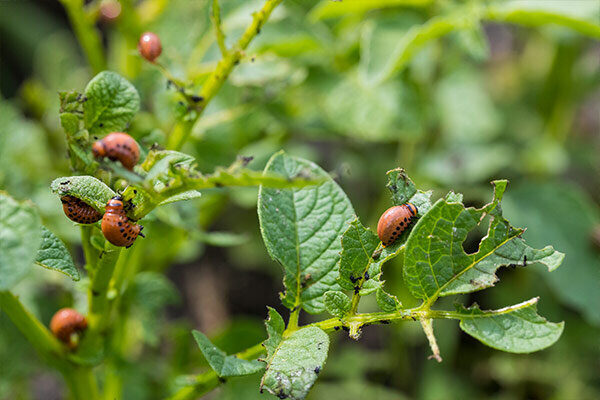If You See These Insects on Your Trees – Panic
So often, we just walk around our yards and mindlessly swat at pests without knowing what we are doing – and sometimes, the things we are swatting at could be extremely dangerous. Most of the time, it is just a mosquito or a fly and there is nothing wrong. However, there are some times that the thing you are trying to move away from your face is dangerous – dangerous to you, dangerous to your children, dangerous to pets, or dangerous to your greenery.
So how can you know what pests to worry about and which ones you can just swat away? It helps to do some research so that you know which one is which and what you need to look for – because it isn’t always the bug itself. Sometimes, you need to know about signs of infestations or colonies because a pest isn’t a big deal unless there are a lot of them. Then, there are times when even one of these pests can be a huge problem.
Here are a few to keep an eye on (though there are many, many more):
Asiatic Garden Beetle
- Relatively new pest to Michigan
- Particularly harmful to crops
- Somewhat hard to spot
If you have a vegetable garden, you are probably afraid of the Asiatic garden beetle. This beetle doesn’t look hazardous, but they are actually quite dangerous. They are particularly hazardous for those who grow potatoes because, while the potatoes might not look harmed at first, they don’t cook normally if they have been feasted on by too many of these pests. However, they are also hazardous for any plants that grow close to the ground. They can feed on the leaves and end up killing the plant.
To spot these bugs, you need to look closely. According to Michigan State University, “Adult Asiatic garden beetles are similar in shape to Japanese beetles, but are somewhat smaller and are an iridescent cinnamon color.” The larvae can often be found in mid- to late May near the soil surface, and it is best to eliminate them in this stage. To do so, you should contact pest control.
Spiders
- Some spiders are helpful, some aren’t
- Make sure you know the dangerous spiders that could be around your home
- When in doubt, stay away
Many of us just don’t like spiders at all – as soon as we see them, we try to find a way to put as much distance between ourselves and the spider as possible. Of course, most spiders aren’t problematic at all. Still, there is a growing number of spiders that are dangerous and can bite.
Black widow bites have been more prevalent in the last few years, which is something that we all need to worry about. The best thing that you can do is learn what the poisonous spiders are and avoid them at all costs. However, you do need to remember that some spiders are great for eliminating other pests.
Griffin Pest has great solutions for eliminating spiders from around your home: “Circle the perimeter of your home a few times. Clear away anything that’s leaning against the house. If you have a pile of firewood, move it away from your house. Regularly trim your hedges and bushes. Look for avenues of infiltration like gaps in the foundation or near utility lines and seal them. ”
American Dagger Moth
- Can particularly hurt children
- Turns from a caterpillar to a moth
- Moths aren’t too bad – but the caterpillars can be dangerous
This is a lesson that many of us learned as children – do not touch caterpillars that look like they are fuzzy, because they most certainly are not. The American Dagger Moth is a moth that you don’t have to worry about too much once it becomes a moth (though they can be quite scary when they are on lights) but when they are still in the caterpillar form, you might want to encourage children to stay away. These caterpillars do sting.
According to Insect Identification, they are most likely to be attracted to oak, ash, elder, willow, and maple trees. They are active mainly in the spring and fall months and can often be found around benches, parks, and thick trees. The caterpillars are easy to identify because they are covered in (what appears to be) soft fuzz with longer, thick, dark bristles. These are the bristles that contain the toxins that deliver the sting. Sometimes, these toxins can result in rashes and hives on the skin – so it is best to stay away from these.
Emerald Ash Borer
- Impact ash trees
- Need to be reported to the professionals
- If you see these, get help as soon as possible
Emerald Ash Borers are terrifying bugs that can create quite a bit of damage in a relatively short amount of time – and they absolutely have to be stopped. This invasive species is one of the most damaging pests that you can have in your yard, and you are obligated to help their spread and start putting an end to their regime.
According to Emerald Ash Borer Info, “Because ash trees (Fraxinus spp.) in North America have no immunity to the insect, EAB has the potential to wipe out more than 700 million ash trees in Michigan. Since 2002, it has killed more than 30 million ash trees in southeastern Michigan alone. State and federal agencies in Michigan, and researchers in Michigan universities, are working to stop EAB from spreading. This includes the initiation of quarantines to stop the movement of infested ash wood and wood products, research to understand the pest’s life cycle and what methods and strategies can control or eradicate it and development of educational and informational materials to help communities detect and deal with EAB infestations.”
If you are looking for more information, you can reach out to the county or your local commissioners to find out more information about any EAB outbreaks in your area.
If you believe that you have a pest problem with your trees or in your yard, give us a call today at (269) 216-6811 and we can set up a time to visit you and your beautiful trees to see just what the problem is – and how we can help you. Even more, if you have been facing issues with your trees and you just want to make sure that they have the best chance of survival into the next season, contact our professionals. There is no job too big or too small.


